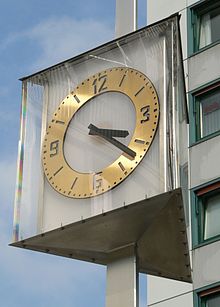Goldsmith School with Watchmaking School Pforzheim
The traditional goldsmith school with watchmaking school is a vocational institution with headquarters and classrooms in St.-Georgen-Steige in Pforzheim . It combines a vocational school , vocational schools for goldsmiths and watchmakers , a master school for goldsmiths and engravers , as well as a vocational college and a technical school for design in the field of jewelry and equipment in one building . This special school of its kind, the only one in Europe, whose aims are the comprehensive teaching and promotion of both manual and technical as well as creative and design skills, attracts not only domestic but also many foreign students.
The school is equipped with goldsmiths, silversmiths , engravers, setters , enamel and watchmaker workshops, a specialist library, as well as an exhibition hall and an auditorium.
history
The school traces its origins back to the year 1767, when a drawing school was opened under Margrave Karl Friedrich von Baden-Durlach in the Pforzheim state orphanage . Shortly before, Karl Friedrich had given three entrepreneurs from Switzerland and France a privilege to set up a watch manufacture in this orphanage. The task of the school was to provide the young local jewelry and watch industry with qualified junior staff who, in addition to their technical training in the company in the drawing school, had also acquired artistic skills. In 1805 a free hand drawing school was founded, which was renamed the Crafts School in 1833 , and just one year later - after the sovereign on behalf of the Grand Ducal Government had ordered the establishment of trade schools in all cities with significant industry, was renamed the Pforzheim Trade School .
From the second half of the 19th century, the history of this school and the facilities that arose from it was shaped by a series of restructuring, renaming, separations and mergers.
An artist class introduced at the trade school in 1868 became independent in 1877 as an arts and crafts school and technical college on Jahnstrasse ( Grand Ducal arts and crafts school and technical school for the metal industry , a predecessor of the Pforzheim University ). A further subdivision took place a little later at the vocational school, which was initially divided into two departments under the same management: a craftsman's department geared to the needs of small businesses , in which more bookkeeping and commercial subjects were taught, and a department more accommodating to the interests of the jewelry industry Goldsmith's department , in which mainly skills in drawing and modeling were taught. In 1892 the trade school (goldsmiths school and future trade school 3 ) separated from its handicraft department and established itself in a new school building on the then still existing Enz island. The year 1905 is given as the official founding date of this goldsmith school . Seven years later, the school on Jahnstrasse was taken over, from which the arts and crafts school moved to Holzgartenstrasse.
One of the better-known students was Eve Hemmerlein-Richter (1914–2001), u. a. represented in the collection of the state of Baden-Württemberg.
The temporary reunification with the arts and crafts school in 1940 under the name Staatliche Meisterschule der deutschen Edelmetall- und Schmuckindustrie Pforzheim, affiliated with the trade school 3, resulted from the recession of the goldsmith's trade caused by the global economic crisis , the correspondingly reduced demand for apprenticeships and the temporary turning of the Students on other professional goals such as those of stone engraver, ivory carver, enamelur, glass cutter or shaper. Lessons, which were suspended due to the destruction of the school building in a bomb attack in 1945, were soon resumed in temporary rooms after the end of the war. From 1949 an empty factory was available in Dillstein , and from 1960 a new building on St.-Georgen-Steige, where the goldsmith's school is located to this day.
The renewed, final separation from the former arts and crafts school, which has now been called the arts and crafts school, goes back to 1966, the last renaming to goldsmiths school with watchmaking school to the takeover of the watch and time measurement department, which was spun off from Pforzheimer Gewerbeschule 1 , in 1973.
See also
- Vocational, technical and technical school for professions in the design of precious metals (Hanau drawing academy)
literature
- 75 years of the Pforzheim Goldsmith School. Self-published , Pforzheim 1980, OCLC 258048447 .
- Goldsmith school with watchmaking school 1983–1984. Self-published, Pforzheim 1984.
Web links
- Goldsmith School with Watchmaking School Pforzheim official website
Individual evidence
- ↑ The Grand Ducal School of Applied Arts and Technical College for the metal industry in 1937 in Baden School of Applied Arts , 1940 in State Meisterschule , 1952 in United goldsmith, Art and Craft School renamed. After being transferred to a technical college ( Fachhochschule für Gestaltung ) in 1971, it was merged with the Fachhochschule für Wirtschaft in 1992 and since 2005 has been officially called Pforzheim University - design, technology, economics and law .

